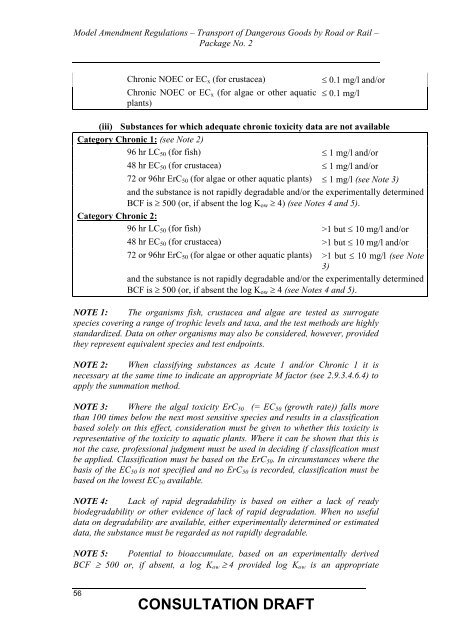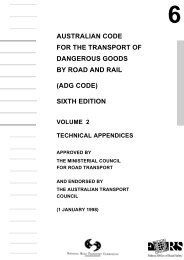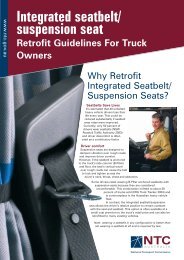Consultation Draft - National Transport Commission
Consultation Draft - National Transport Commission
Consultation Draft - National Transport Commission
Create successful ePaper yourself
Turn your PDF publications into a flip-book with our unique Google optimized e-Paper software.
Model Amendment Regulations – <strong>Transport</strong> of Dangerous Goods by Road or Rail –<br />
Package No. 2<br />
Chronic NOEC or EC x (for crustacea)<br />
Chronic NOEC or EC x (for algae or other aquatic<br />
plants)<br />
0.1 mg/l and/or<br />
0.1 mg/l<br />
(iii) Substances for which adequate chronic toxicity data are not available<br />
Category Chronic 1: (see Note 2)<br />
96 hr LC 50 (for fish) 1 mg/l and/or<br />
48 hr EC 50 (for crustacea) 1 mg/l and/or<br />
72 or 96hr ErC 50 (for algae or other aquatic plants) 1 mg/l (see Note 3)<br />
and the substance is not rapidly degradable and/or the experimentally determined<br />
BCF is 500 (or, if absent the log K ow 4) (see Notes 4 and 5).<br />
Category Chronic 2:<br />
96 hr LC 50 (for fish) >1 but 10 mg/l and/or<br />
48 hr EC 50 (for crustacea) >1 but 10 mg/l and/or<br />
72 or 96hr ErC 50 (for algae or other aquatic plants) >1 but 10 mg/l (see Note<br />
3)<br />
and the substance is not rapidly degradable and/or the experimentally determined<br />
BCF is 500 (or, if absent the log K ow 4 (see Notes 4 and 5).<br />
NOTE 1: The organisms fish, crustacea and algae are tested as surrogate<br />
species covering a range of trophic levels and taxa, and the test methods are highly<br />
standardized. Data on other organisms may also be considered, however, provided<br />
they represent equivalent species and test endpoints.<br />
NOTE 2: When classifying substances as Acute 1 and/or Chronic 1 it is<br />
necessary at the same time to indicate an appropriate M factor (see 2.9.3.4.6.4) to<br />
apply the summation method.<br />
NOTE 3: Where the algal toxicity ErC 50 (= EC 50 (growth rate)) falls more<br />
than 100 times below the next most sensitive species and results in a classification<br />
based solely on this effect, consideration must be given to whether this toxicity is<br />
representative of the toxicity to aquatic plants. Where it can be shown that this is<br />
not the case, professional judgment must be used in deciding if classification must<br />
be applied. Classification must be based on the ErC 50 . In circumstances where the<br />
basis of the EC 50 is not specified and no ErC 50 is recorded, classification must be<br />
based on the lowest EC 50 available.<br />
NOTE 4: Lack of rapid degradability is based on either a lack of ready<br />
biodegradability or other evidence of lack of rapid degradation. When no useful<br />
data on degradability are available, either experimentally determined or estimated<br />
data, the substance must be regarded as not rapidly degradable.<br />
NOTE 5: Potential to bioaccumulate, based on an experimentally derived<br />
BCF 500 or, if absent, a log K ow 4 provided log K ow is an appropriate<br />
56<br />
CONSULTATION DRAFT






